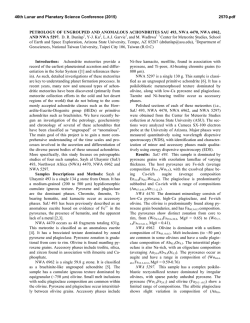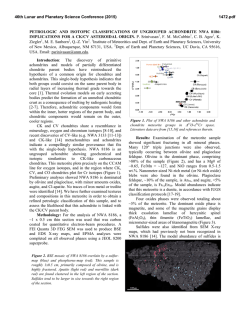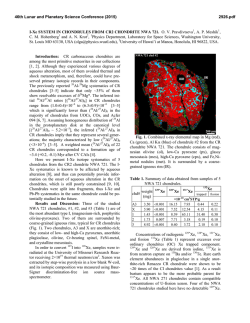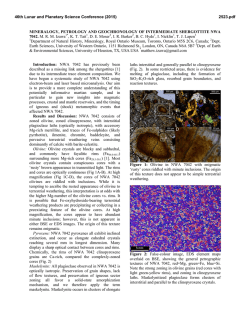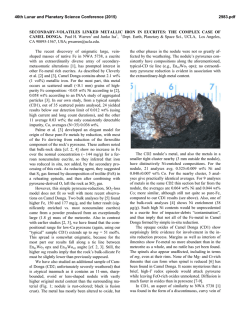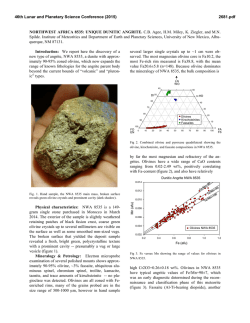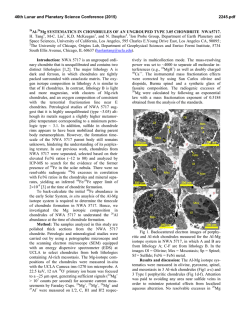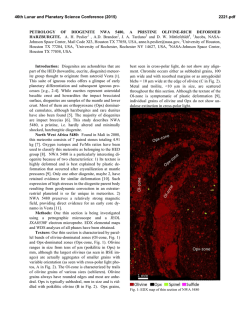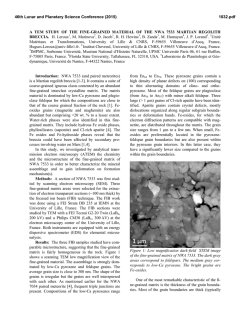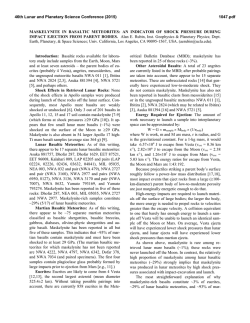
NWA 8614: THE LEAST HEATED WINONAITE? K. R. Farley1, A. M.
46th Lunar and Planetary Science Conference (2015) 1821.pdf NWA 8614: THE LEAST HEATED WINONAITE? K. R. Farley1, A. M. Ruzicka1, and K. Armstrong1, 1 Cascadia Meteorite Laboratory, Department of Geology, Portland State University, 1721 SW Broadway, Portland, OR, 97207, ([email protected], [email protected]). Introduction: Northwest Africa 8614 is classified as a winonaite on the basis of oxygen isotope ratios, mineralogy, and highly reduced chemistry [1]. Unlike other winonaites, it contains numerous and readily apparent chondrules. Here we describe textures, mineralogy, mineral compositions, O-isotope composition, and geothermometry results for NWA 8614 and discuss the possible significance of the meteorite. Methods: Petrological and chemical analyses were performed using optical microscopy with a DM2500 Leica petrographic microscope and a Zeiss Sigma VPFEG scanning electron microscope (SEM) with a highefficiency energy dispersive spectrometer (EDS) at Portland State University. Phase compositions were determined by quantitative EDS analyses; modal mineralogy was determined by EDS mapping of an entire thin section to generate false color phase maps, assigning false colors to X-ray intensity images (e.g. Fig. 1), and using ImageJ software to analyze color proportions. Oxygen isotopes were analyzed by Karen Ziegler at the University of New Mexico on acid-washed samples to remove terrestrial weathering products. Petrography, mineralogy, and compositions: The available data indicates that NWA 8614 is a winonaite, but of an unusual type. Mineralogy and texture. NWA 8614 has a texture that is primarily granoblastic. The mode of the meteorite is as follows (in area %): 44.3 low-Ca pyroxene, 12.3 olivine, 10.6 kamacite, 10.1 plagioclase, 6.9 troilite, 4.6 diopside, 1.4 taenite, 0.21 daubreelite, 0.17 schreibersite, 0.7 phosphate, 0.4 chromite, and 8.4 metal weathering product. This pyroxene- and metalrich mineralogy is consistent with winonaites, as is the presence of daubreelite and schreibersite [2, 3]. There is a collection of metal grains that roughly form a veinlike metal structure. Similar veins are found in other winonaites [2, 3]. Chondrules. The most remarkable feature of NWA 8614 is the presence of distinct and relatively abundant chondrules, with over a dozen chondrules apparent in two small thin sections (Fig. 1). Chondrule diameters measured in thin section are 0.48 ± 0.27 mm (N = 13). Barred and microporphyritic textures are common. Chondrules tend to be rich in either olivine or low-Ca pyroxene, and diopside is often enriched in relict chondrules relative to the surrounding host (Fig. 1). Figure 1. False-color EDS map of NWA 8614 showing two chondrules (left side). Phases include olivine (ol, green), orthopyroxene (opx, brown), diopside (diop, purple red), plagioclase (plag, purple), kamacite or weathered low-Ni metal (kam, light blue), taenite (tae, dark blue), troilite (troi, light yellow), phosphate (phos, orange), and chromite (pink, too small to see clearly here). Dark areas with or without purple centers are pits produced by mineral plucking. Scale bar at lower left is 0.5 mm. Figure 2. Olivine and pyroxene compositions in NWA 8614 compared to various winonaites. Error bars for NWA 8614 are roughly the size of the symbol. For literature data, ranges are represented as lines, error bars are represented as thicker bars. Clinopyroxene temperatures (in °C) are shown in small font. NWA 4937 and 1463 are labeled. The equilibrium line shows Fe-Mg equilibrium between olivine and pyroxene [4]. Mineral chemistry. Mineral chemistry was determined to be Mg-olivine (Fa 6.5 ± 0.5, Fe/Mn = 13 ± 2 46th Lunar and Planetary Science Conference (2015) at., N=18), low-Ca Mg-pyroxene (Fs 7.8 ± 0.3 Wo 1.4 ± 0.2 En 90.9 ± 0.5, Fe/Mn = 8.8 ± 0.8 at., N=28), diopside (Fs 3.5 ± 0.5 Wo 45.5 ± 0.3, En 50.9 ± 0.5, N=19), and plagioclase (Ab 79.9 ± 2.0 Or 6.4 ± 1.2 An 13.6 ± 1.2, N=23). Olivine and pyroxene compositions are highly uniform, suggesting an approach to equilibrium. The mineral compositions are generally intermediate to winonaites and acapulcoites [2] but overlap that of the winonaites at the ferroan end (Fig. 2). Oxygen isotopic composition. Although mineral compositions for NWA 8614 conceivably permit either acapulcoite or winonaite designations, the oxygen isotope compositions show NWA 8614 is more consistent with a winonaite (Fig. 3). Figure 3. δ18O (‰) vs Δ17O (‰) values for NWA 8614 compared to literature data for winonaites [1, 3, 5-8]. NWA 8614 extends the winonaite line to the left. Acapulcoite/Lodranite shown for comparison [9]. Geothermometry. The two-pyroxene thermometer [10] and the olivine-spinel thermometer [11] were used to calculate closure temperatures (Table 1). The temperatures determined for low-Ca and high-Ca pyroxene in NWA 8614 are in agreement with each other, and with the olivine-spinel geothermometer (Table 1). This suggests that ferromagnesian phases in NWA 8614 largely equilibrated, at ~820-860 °C. These temperatures are similar to, but are slightly lower than, other winonaites (Table 1). Discussion: Owing to the abundance of chondrules, NWA 8641 may be one of the least heated winonaites, and therefore may provide clues to the chondritic protolith of the winonaite parent body. Overall textures are similar to those found in type 6 chondrites that escaped significant melting. One other winonaite, NWA 1463, is reported to have multiple relict chondrules [12, 13], but these two meteorites are not paired as mineral compositions are different (Fig. 2). NWA 8614 is more ferroan than most winonaites but resembles NWA 4937 (Fig. 2). However the mineralogy between the two is 1821.pdf very different, with the latter containing only small amounts of olivine [1]. Table 1: Two-pyroxene and olivine-spinel temperatures for NWA 8614 compared to other winonaites. For olivine-spinel, average olivine (Ol) and chromite (Sp) compositions were assumed; for low-Ca pyroxene (OPX) and diopside (CPX), individual analyses were used. NWA 8614 OPX NWA 8614 CPX Literature Data OPX Literature Data CPX NWA 8614 Olivine-Spinel Temperature (°C) 857 ± 26 818 ± 20 930 ± 52 867 ± 89 858 Number analyses 12 14 16 12 10 (Ol)/6 (Sp) Despite similar geothermometer temperatures for various mineral pairs, NWA 8614 apparently did not attain Fe-Mg equilibrium between olivine and pyroxene. Like other winonaites, NWA 8614 has olivine compositions that are too magnesian for equilibrium relative to low-Ca pyroxene (Fig. 2). This discrepancy could be caused by preferential FeO-reduction of olivine [3]. Although NWA 8614 lies closer to olivinepyroxene Fe-Mg equilibrium than some winonaites, other winonaites with different Fe/Mg plot similarly close to the equilibrium line (Fig. 2). Among winonaites as a whole, there is no evidence for a curved trend between Fa and Fs compositions as would be expected for FeO-reduction during metamorphism [3], nor for mineral compositions that correlate with geothermometry temperatures (Fig. 2). This argues against a single metamorphic FeO-reduction trend from a common chondritic precursor. Instead, protoliths for different winonaites may have varied slightly in composition. References: [1] Meteoritical Bulletin Database, accessed 2014. [2] Hutchison R. (2004) Meteorites—A petrologic, chemical and isotopic synthesis, 506 pp. [3] Benedix G.K. et al. (1998) GCA, 62, 2535-2553. [4] Beattie P. (1993) Contrib. Mineral. Petrol., 115, 103111. [5] Greenwood R.C. et al. (2012) GCA, 94, 146163. [6] Clayton R. N. and Mayeda K. (1996) GCA, 60, 1999-2017. [7] Kimura M. et al. (1992) Antarctic Met. Res., 5, 165-190. [8] Yugami K. et al (1998) Antarctic Met. Res., 11, 49-70. [9] Franchi I. (2008) Reviews in Mineral. & Geochem., 68, 345-397. [10] Lindsley D.H (1983) Am. Mineral., 68, 477-493. [11] Wlotzka F. (2005) Meteoritics & Planet. Sci., 40, 1673-1702. [12] Floss C. et al. (2008) Meteoritics & Planet. Sci., 43, 657-674. [13] Benedix G. K. (2003) Meteoritics & Planet. Sci., 38, A70.
© Copyright 2025

